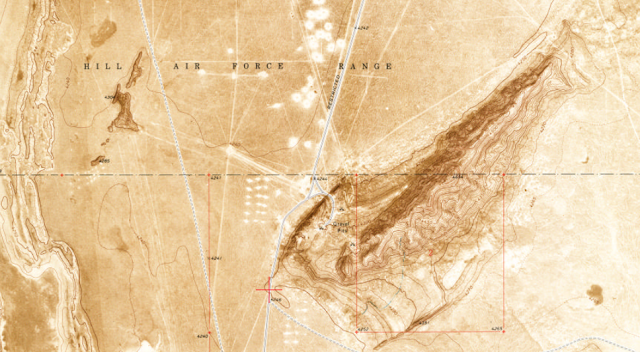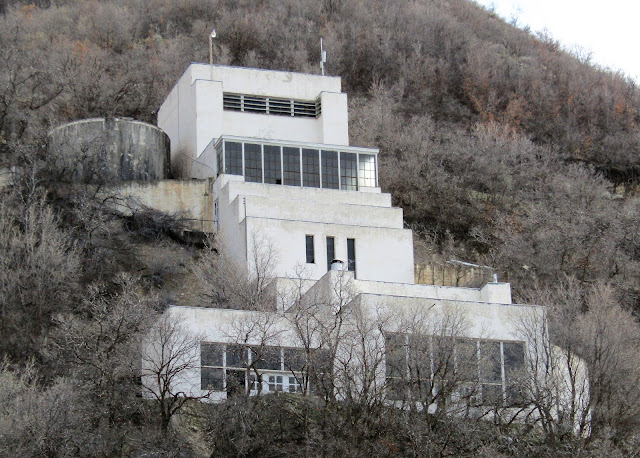Bank by Mail
This is the first in a series of posts from a recent trip to Vernal. I highly recommend Vernal, especially with young kids. There's a lot to do there, particularly with dinosaurs, and hotels are very cheap, especially in the fall. A decent mid-range hotel can be as low as $55 per night in October.
So, on to the story of the Bank of Vernal.
In 1916, the directors of the Bank of Vernal decided to construct a new bank building, now at the corner of Main Street (US-40) and Vernal Avenue (US-191 north of Main Street). Although they planned to use locally produced brick for most of the building, they wanted to use more expensive (because it had more uniform size and corners) pressed brick for the outer facade.
The nearest source of pressed brick were the brickyards of Salt Lake City, about 125 miles to the west. Vernal has never had a rail connection, and at this time there were no good road connections. Shipping to Vernal took the Denver & Rio Grande Western Railroad south through Spanish Fork Canyon to Mack, Colorado (near Grand Junction), was transhipped onto the Uintah Railway to Watson, Utah (a Gilsonite mining town, now a ghost town), and then placed onto trucks for the last 54 miles into Vernal. The cost to have a freight company ship the over 37 tons of brick needed to complete the facade would have run to four times the cost of the bricks themselves.
Luckily for the Bank of Vernal and its shareholders, the US Postal Service had recently (in 1913-1914) increased the allowable weight for parcel post from 4 to 50 pounds. Large amounts of food, construction materials, and consumer goods were shipped into Vernal via the Post Office. In 1916, a 50-pound box of goods cost only 54 cents to ship from Salt Lake. The postal service lost tens of thousands of dollars per year shipping to Vernal.
The Salt Lake Pressed Brick Company shipped somewhere between 15,000 and 80,000 bricks to Vernal during the summer and fall of 1916 by wrapping each brick individually and placing them 10 to a wooden crate. Due in part to this action, the postal service instructed their branches not to ship more than 200 pounds from a single seller to a single recipient per day without special permission.
The bank was completed in November 1916 and the bank moved in the next February. The building still stands on the southwest corner of Main and Vernal and is now a Zions Bank.
So, on to the story of the Bank of Vernal.
In 1916, the directors of the Bank of Vernal decided to construct a new bank building, now at the corner of Main Street (US-40) and Vernal Avenue (US-191 north of Main Street). Although they planned to use locally produced brick for most of the building, they wanted to use more expensive (because it had more uniform size and corners) pressed brick for the outer facade.
 |
| The Bank of Vernal |
The nearest source of pressed brick were the brickyards of Salt Lake City, about 125 miles to the west. Vernal has never had a rail connection, and at this time there were no good road connections. Shipping to Vernal took the Denver & Rio Grande Western Railroad south through Spanish Fork Canyon to Mack, Colorado (near Grand Junction), was transhipped onto the Uintah Railway to Watson, Utah (a Gilsonite mining town, now a ghost town), and then placed onto trucks for the last 54 miles into Vernal. The cost to have a freight company ship the over 37 tons of brick needed to complete the facade would have run to four times the cost of the bricks themselves.
 |
| The direct and shipping distances from Salt Lake to Vernal. From the USPS Historian's Bank of Vernal history. |
Luckily for the Bank of Vernal and its shareholders, the US Postal Service had recently (in 1913-1914) increased the allowable weight for parcel post from 4 to 50 pounds. Large amounts of food, construction materials, and consumer goods were shipped into Vernal via the Post Office. In 1916, a 50-pound box of goods cost only 54 cents to ship from Salt Lake. The postal service lost tens of thousands of dollars per year shipping to Vernal.
The Salt Lake Pressed Brick Company shipped somewhere between 15,000 and 80,000 bricks to Vernal during the summer and fall of 1916 by wrapping each brick individually and placing them 10 to a wooden crate. Due in part to this action, the postal service instructed their branches not to ship more than 200 pounds from a single seller to a single recipient per day without special permission.
 |
| The north side of the facade, with the famous pressed brick. |
The bank was completed in November 1916 and the bank moved in the next February. The building still stands on the southwest corner of Main and Vernal and is now a Zions Bank.


Comments
Post a Comment